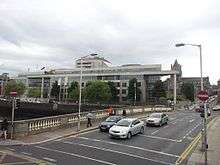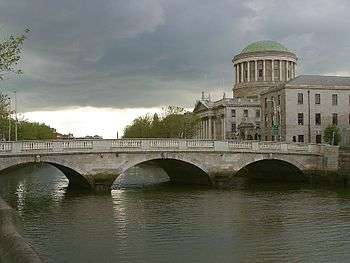O'Donovan Rossa Bridge
| O'Donovan Rossa Bridge Droichead Uí Dhonnabháin Rosa | |
|---|---|
|
O'Donovan Rossa Bridge and the Four Courts | |
| Coordinates | 53°20′43″N 6°16′20″W / 53.3453°N 6.2722°WCoordinates: 53°20′43″N 6°16′20″W / 53.3453°N 6.2722°W |
| Crosses | River Liffey |
| Locale | Dublin |
| Preceded by |
New Bridge (First built 1682) Ormond Bridge (Rebuilt 1684) Richmond Br. (New location 1816) O'Donovan Rossa Br. (Renamed 1923) |
| Characteristics | |
| Material | Granite masonry |
| Total length | 44m[1] |
| Width | 15m[1] |
| Number of spans | 3 |
| History | |
| Designer | George Knowles |
| Opened | 1816 |

O'Donovan Rossa Bridge (Irish: Droichead Uí Dhonnabháin Rosa)[2] is a road bridge spanning the River Liffey in Dublin, Ireland and joining Winetavern Street to Chancery Place (at the Four Courts) and the north quays.
Replacing a short lived wooden structure, the original masonry bridge on this site was built in 1684 as a five-span simple arch bridge, and named Ormonde Bridge.[1] In December 1802 this bridge was swept away during a severe storm.
In 1813 construction started on a replacement bridge — the current structure — a little further west to the designs of James Savage and was opened in 1816.[3] It consists of three elliptical arch spans in granite, with sculptured heads, similar to those on O'Connell Bridge, on the keystones. The heads represent Plenty, the Liffey, and Industry on one side, with Commerce, Hibernia and Peace on the other. The balustrades are of cast-iron.
Opened as Richmond Bridge (for the Duke of Richmond Lord Lieutenant of Ireland), it was renamed in 1923 for Jeremiah O'Donovan Rossa by the fledgeling Free State.[4]
